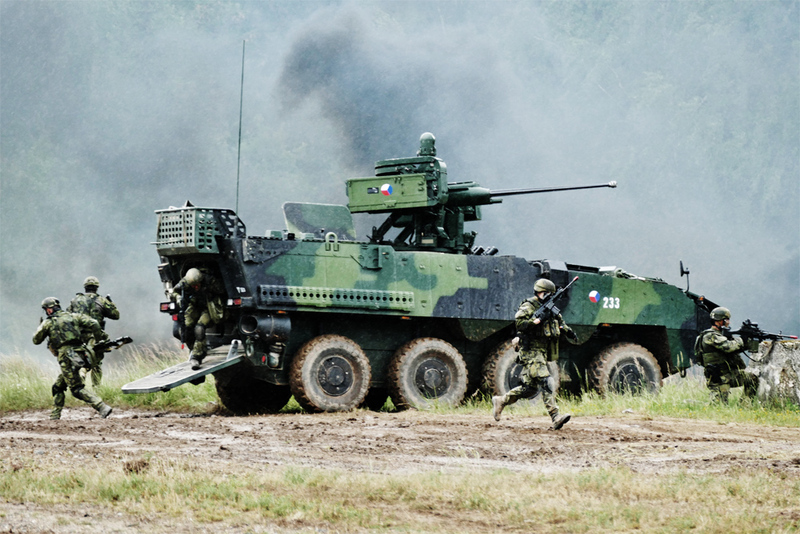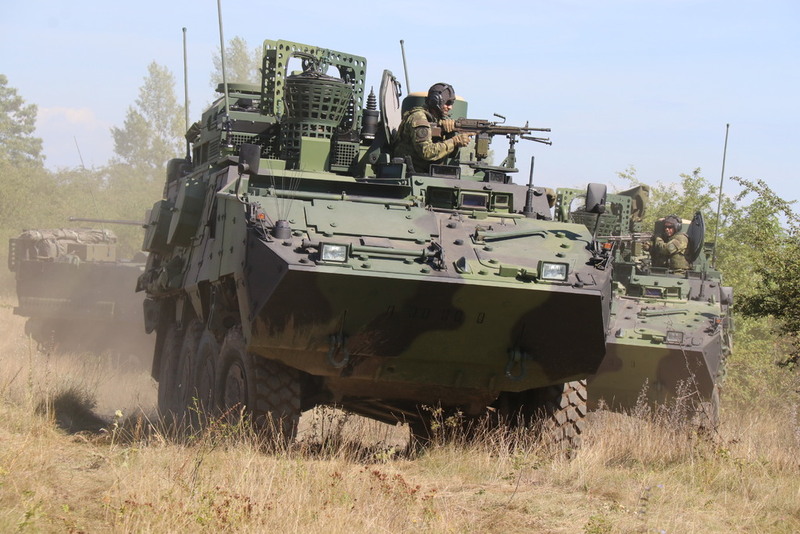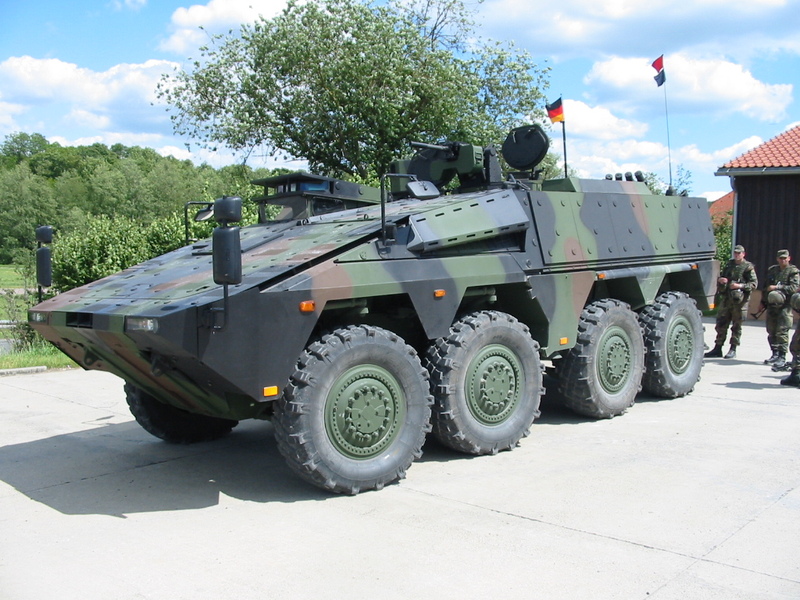Pandur Armored Personnel Carriers and their possibilities for the future
One of the most interesting news from the Czech defense industry in 2020 was the announcement of a contract for the sale of Pandur II 8 × 8 Armored Personnel Carriers to the Republic of the Philippines. Czechoslovak Group (CSG) industrial holding, resp. Excalibur Army (EA) and Tatra Defense Vehicle (TDV), in cooperation with GDELS, will supply the Philippines with a total of 10 Pandur II Armored Personnel Carriers in the fire support vehicle version equipped with a 105 mm cannon. This contract is to some extent a follow-up to the recent deliveries of Pandur Armored Personnel Carriers to Indonesia. These are relatively small numbers (however, it is possible that these orders will be expanded), but it can be stated that this is one of the biggest export successes of the Czech defense industry in the entire post-1989 history, when it comes to new production systems and not sales from surpluses. It also means success for the Pandur Armored Personnel Carriers as such, and it is likely that these successes will be followed up by other similar contracts. This is one of the reasons why it is worth noticing the Pandur Armored Personnel Carriers more deeply.
 Picture: Fire support vehicle intended for the Philippines on the Pandur II platform (visualization in the picture), equipped with a rifled 105 mm cannon | Elbit Systems / CC BY NC-ND
Picture: Fire support vehicle intended for the Philippines on the Pandur II platform (visualization in the picture), equipped with a rifled 105 mm cannon | Elbit Systems / CC BY NC-ND
Pandur Armored Personnel Carriers
At the same time, the Pandur Armored Personnel Carriers are currently celebrating another success, namely the tenth anniversary of the operation of this type in the Army of the Czech Republic. A recent article in the ATM magazine was devoted to the service of the Pandur Armored Personnel Carriers in the Czech Armed Forces, and therefore this chapter will not be discussed further here. The aim is rather to point out the importance and potential of Pandur Armored Personnel Carriers for the Czech defense industry.
It was for the Czech defense industry that the Pandur Armored Personnel Carriers were of considerable benefit. When these were introduced the Government demanded the involvement of the domestic defense industry when negotiating a contract for new Armored Personnel Carriers. And today, over time, it turns out how pragmatic this decision was, which is also confirmed by the above-mentioned foreign contracts. Everything was exacerbated by the decision of GDELS (the original supplier of Pandurs for the Czech Armed Forces) to fully leave the production of Pandur Armored Personnel Carriers to the Czech Republic, resp. CSG holding. The Czech defense industry thus gained the ability to produce an Armored Personnel Carrier on its own, which is an ability that relatively few countries in Europe have. Thanks to the Pandur Armored Personnel Carriers, the Czech defense industry has continued the tradition begun by the OT-64 Armored Personnel Carriers.
In addition, it should be noted here that it is not only the CSG holding company, respectively EA and TDV, but also a whole series of other, smaller companies that participate in the production of Pandur Armored Personnel Carriers by subcontracting components. Pandur Armored Personnel Carriers thus create a certain phenomenon, both from an industrial and economic point of view. However, Pandur Armored Personnel Carriers are also interesting from a purely technical point of view, even in a worldwide comparison. And it could be said that today's times only wish for this type, and perhaps paradoxically even more than at the time of their creation.
Pandur Armored Personnel Carriers are to some extent unpopular with the Czech lay public, mainly due to corruption cases associated with their acquisition. It should be noted here that similar cases of corruption have occurred in other military acquisitions, not only in the Czech Republic but also elsewhere in the world. And above all, these corruption cases do not in any way indicate anything about the very technical and combat qualities of the Pandur transporters.
 Picture: Pandur II 8x8 Wheeled Armored Personnel Carrier in the service of the Czech Armed Forces | Ministry of Defense of the Czech Republic
Picture: Pandur II 8x8 Wheeled Armored Personnel Carrier in the service of the Czech Armed Forces | Ministry of Defense of the Czech Republic
Likewise, Pandur Armored Personnel Carriers are sometimes criticized by the professional public. It is often criticized that Pandur Armored Personnel Carriers are old, as the first vehicles of this type appeared in the 1980s. This is one of the reasons why Pandur Armored Personnel Carriers are sometimes referred to as obsolete. In this respect, it is worth remembering that the well-known Piranha Armored Personnel Carriers are even older, and yet they are still being manufactured - with the fact that today's version of Piranha V is of course in many ways different from the original version of Piranha I. In the same way, today's Pandurs II are completely different from the first variants of Pandurs.
Sometimes the criticism also points to the fact that the Pandur Armored Personnel Carriers were created primarily in a six-wheel version - and the current 8x8 version of the Pandur II is merely a derivative of it. However, this statement does not in any way indicate anything on the qualities of the given type. In fact, it is only an adjustment, respectively. extension of some parts. And it should also be noted that such a procedure is quite common, and even today Armored Personnel Carriers are commonly created in both eight-wheeled and six-wheeled versions, as shown by modern Turkish transporters Arma, etc.

Picture: The command-staff and communications Pandur | Ministry of Defense of the Czech Republic
It is also often pointed out that the relatively light, less protected Pandur Armored Personnel Carriers are already obsolete, and that modern types of Armored Personnel Carriers are technically completely different. However, such an evaluation of Pandur Armored Personnel Carriers is erroneous; it is a consequence of the underestimation of the position of Pandur Armored Personnel Carriers in the category of armored wheeled carriers, or wheeled infantry fighting vehicles.
Armored Personnel Carriers today
The whole category of Armored Personnel Carriers in the 8x8 arrangement (which is the most common today, ten-wheeled types have hardly prevailed, six-wheeled ones are no longer suitable) has undergone considerable change in recent years. This is largely due to the experience of conflicts in Afghanistan and Iraq, but also to a number of different asymmetric conflicts in the developing world, where older types of wheeled transporters have proved not entirely satisfactory. Today's Armored Personnel Carriers are somewhere else than their ideological predecessors, which were born in the sixties of the last century, such as the Russian BTR-60 Armored Personnel Carrier or the first Western types.
Above all, the trend towards ever higher protection is obvious. As a result, however, modern wheeled Armored Personnel Carriers are becoming increasingly heavier. The weight of modern types, such as the German Boxer or the French VBCI (but also Chinese types of carriers), normally exceeds 30 tons. And in recent years, even heavier wheeled Armored Personnel Carriers have appeared. It is mainly the Israeli Eitan type, whose weight is to be around 35 tons. And other types are beginning to approach this limit. At the same time, it cannot be ruled out that the weight of the Armored Personnel Carriers will continue to increase, and that it will reach the limit of 40 tons, ie the weight of the T-72 tank. However, such a high weight complicates the deployment of these Armored Personnel Carriers in difficult terrain. This is one of the reasons why there is a growing interest in lighter types, as indicated, for example, by the continued production of Russian BTR-82 vehicles or Ukrainian BTR-3 vehicles.
_(cropped).jpg) Picture: Israeli 8 × 8 Eitan heavy wheeled armored personnel carrier | Zachi Evenor / IDF / CC BY 2.0
Picture: Israeli 8 × 8 Eitan heavy wheeled armored personnel carrier | Zachi Evenor / IDF / CC BY 2.0
Another obvious trend is the increase in the dimensions of Armored Personnel Carriers. This is the result not only of the need to provide the vehicle with the necessary level of protection, but also of the effort to ensure the best possible ergonomics and maximum comfort for the crew. As a result, however, modern types are very large. It is, for example, the already mentioned Eitan type, but also the Kazakh Barys type, etc. These carriers are more than 8 meters long and their total height is around 3.5 meters. The size itself then complicates the deployment of these vehicles in difficult terrain and their transport.
Last but not least, modern Armored Personnel Carriers are very expensive and the high price often prevents them from being introduced into service in sufficient numbers. Some armies are solving this problem by introducing more armored cars. However, it is clear that this solution is not ideal (armored cars have, for example, lower cross-country capability) and that for many situations, the classic 8x8 Armored Personnel Carrier is much better.
On the other hand, older types of Armored Personnel Carriers are still in operation, such as the Russian BTR-60/70/80 series in particular. Although these Armored Personnel Carriers are very light (approx. 14 tons), they are also not very durable. An even bigger handicap is their concept with the engine located at the rear and cramped space for the crew. Thousands of these Armored Personnel Carriers are in service around the world, and it is clear that they cannot serve indefinitely and will sooner or later have to be replaced. And it is in this situation that the Pandur Armored Personnel Carriers fit properly. It can be said that they are located exactly somewhere between the mentioned counterparts in the category of eight-wheel armored personnel carriers.
_(cropped).jpg) Picture: Soviet BTR-80 8 × 8 wheeled amphibious armored vehicle | Vitaly V. Kuzmin / CC BY-SA 4.0
Picture: Soviet BTR-80 8 × 8 wheeled amphibious armored vehicle | Vitaly V. Kuzmin / CC BY-SA 4.0
A somewhat overlooked fact about Pandur Armored Personnel Carriers is their weight, which only slightly exceeds 20 tons and thus belongs in its category among the lightest Western armored personnel carriers, respectively. They are de facto the lightest of the types produced. A not insignificant advantage of Pandur is its ability to swim, which heavy types of transporters already lack.
The Pandur Armored Personnel Carrier has all the features of a modern western type, especially a sufficiently comfortable troop compartment located in the rear of the vehicle, which differs, for example, from the Russian BTR series. It is surpassed by stronger armor and the advantage is also its relatively sophisticated equipment and modern electronics. Pandurs cannot be compared to the most modern Western types, such as the already mentioned Boxer or Eitan type, but they can suitably complement these Armored Personnel Carriers; they can be used where the use of these heavy and bulky types is excluded.
It is perhaps significant that Pandur Armored Personnel Carriers were exported to Indonesia and the Philippines. Both of these countries are characterized by relatively demanding terrain, which is not suitable for the deployment of heavy armored vehicles. Both countries also still have a relatively weak economy, which does not allow them to acquire the latest technology. Increasing tensions in Southeast Asia are forcing these countries to spend more on their military, and they are usually buying cheaper and less demanding equipment. And it's not just Indonesia and the Philippines. Nearby Vietnam has a similar disposition, with which the Czech Republic has very good relations and whose army uses a large number of Czech military equipment. However, there are other countries in Southeast Asia that will need new carriers over time.

Picture: Boxer is a heavy wheeled armored personnel carrier, developed in cooperation between Germany and the Netherlands. | Heldt / Public domain
The states of South America are in a similar situation. They are also characterized by challenging terrain complicating the deployment of heavy equipment and their armies are usually looking for a cheaper solution as part of modernization. The situation is similar in Africa, where some states are fighting various internal enemies, Islamic terrorism, etc.
It is therefore clear that there are more than enough potential customers, although of course the way to reach a specific contract is always difficult. Pandur Armored Personnel Carriers thus have considerable commercial and therefore economic potential. This is, of course, a benefit for the state itself and its economy.
If this potential is to be fully utilized, then it is important that in the further development of the Pandur II Armored Personnel Carrier, the manufacturer cooperates as much as possible with the Czech Armed Forces, but also other institutions (Military Technical Institute, Technology Agency of the Czech Republic, etc.). Experience from abroad clearly shows that this is the only way to achieve real success. It is advantageous for the manufacturer to develop such a system, which is also of interest to the domestic army, because it then becomes a significant reference customer (even in the case of the introduction of only a limited number). But such cooperation is also beneficial for the army, because it obtains valuable information - and in some cases the manufacturer can produce the vehicle exactly according to its requirements.
From the point of view of export opportunities, it can be highly appreciated that in addition to the Czech version operated by the Czech Army, armed with the Israeli Samson RCWS-30 turret (mounted with a 30 mm cannon of the 30x173 mm western caliber), the Corsac 8x8 was also developed on the basis of the Pandur Armored Personnel Carrier, equipped with a Slovak Turra 30 turret, mounted with the Russian 2A42 30 mm automatic cannon using the "eastern" 30x165 mm ammunition. Especially those states that still use the 2A42 cannon on their BVP-2 vehicles can be interested in this version.
Much more important are the support versions, which are common in the category of Armored Personnel Carriers. However, their development should be the result of the best possible cooperation of individual participants - the army, the manufacturer, but also the state as such. This is, for example, the already mentioned version of the fire support vehicle, equipped with an Elbit turret and mounted with a powerful 105 mm cannon. Also interesting is the mortar carrier version of Pandur for the Czech Army, which has repeatedly declared the need for self-propelled mortars. It is a ShM Pandur II 8x8 self-propelled mortar equipped with the Soltam Card caliber 120 mm weapon. There could be more similar hypothetical variants of the Pandur Armored Personnel Carrier. The author mentioned only those variants which are the most common in other Armored Personnel Carriers and which, in his opinion, would be the most beneficial for the Czech Army.
From the above, it is clear that Pandur Armored Personnel Carriers have their considerable potential, not only technical, but also commercial and economic. Developing this potential could be beneficial not only for the Czech Army, but also for the Czech defense industry. Last but not least, it would also be an economic benefit for the state as such, for its economy, not only in the form of taxes and levies, but also in the form of technological progress.





















